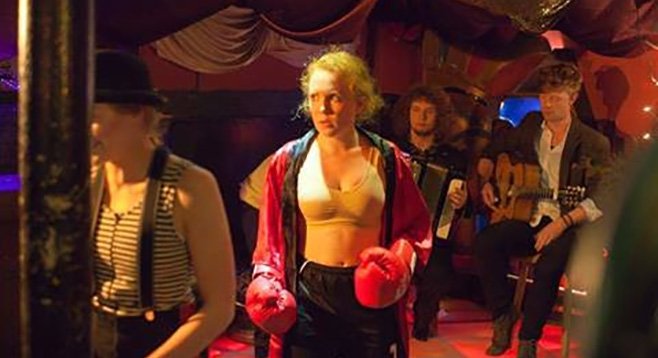 Facebook
Facebook
 X
X
 Instagram
Instagram
 TikTok
TikTok
 Youtube
Youtube

It’s too bad San Diego can’t just adopt the Haste Theatre. Give them a nice, intimate space and let them showcase their fantastical (sometimes tragical) tales. Not only that, the London-based group would give locals an on-going education, by example, about spontaneous performance. They’re so in the moment they seem motive-free.
And all done with such a deceptively light touch their skills come as a surprise.
Last year Haste captivated Fringe audiences with Oyster Boy, a seemingly simple tale with serious consequences. The piece was such a hit they led off this year’s festival with encore performances.
This year’s entrant’s the myth of Theseus, Ariadne, and the Minotaur. Proud Theseus has come to Crete to slay the half-man, half-bull, fathered by King Minos. Ariadne, the king’s daughter, falls for Theseus. She gives him a spool of thread so he can wend his way through the labyrinth.
The Hideout has a connection with Oyster Boy. Both are about the birth of “monsters,” which wouldn’t be if just left alone, and the “monsters” who give them grief.
Theseus slays the Minotaur. He and Ariadne try to flee from Crete but, as so often happens to the women in his legends — most of whom he abducts and then dumps — Theseus mucks things up.
The Haste Theatre’s seemingly abrupt conclusion will make more sense if you know, going in, that Theseus is a Hall of Fame, first-ballot, Love Nazi.
Haste turns the tale into a circus of inventive stunts and bits: Theseus does cartwheels while wearing red boxing gloves (his/her abs highlighted like the Spartans in 300); a clarinet intones the foghorn of a ferry; the Minotaur’s two women who tap-dance (quite well, in fact); silhouetted puppets recreate the Minotaur’s indelicate conception. And Ariadne’s decked out in a stylish, spangly flapper.
That’s because we’re in a 1920s “hideout.” It’s the “boudoir of Dionysus,” Greek god of wine and revelry. Like Frankie and the Rat Pack, Theseus hangs out with now long-forgotten deities: Hades, Poseidon, and — and I can NOT, for the life of me, read my note for the third name; one of these days, I swear, I’m getting a penlight!
The quartet reenacts stories for their patrons — i.e. us. We even have the illusion of picking which one (it turns out that the rejected choice, Romeo and Juliet, connects with the Theseus legend: Romeo slays Juliet’s brother, Tybalt; Theseus slays Ariadne’s brother, the Minotaur).
And they are funny. And swift, even when they seem to be fumbling. And they’re a textbook example of “Post Dramatic” theater, in that they turn passive spectators into active participants. Their “stage” ends behind the house seats.
The Hideout’s a must see. And when you go, remember that Theseus’s heart, for all his amatory protestations, suffers from chronic amnesia.


It’s too bad San Diego can’t just adopt the Haste Theatre. Give them a nice, intimate space and let them showcase their fantastical (sometimes tragical) tales. Not only that, the London-based group would give locals an on-going education, by example, about spontaneous performance. They’re so in the moment they seem motive-free.
And all done with such a deceptively light touch their skills come as a surprise.
Last year Haste captivated Fringe audiences with Oyster Boy, a seemingly simple tale with serious consequences. The piece was such a hit they led off this year’s festival with encore performances.
This year’s entrant’s the myth of Theseus, Ariadne, and the Minotaur. Proud Theseus has come to Crete to slay the half-man, half-bull, fathered by King Minos. Ariadne, the king’s daughter, falls for Theseus. She gives him a spool of thread so he can wend his way through the labyrinth.
The Hideout has a connection with Oyster Boy. Both are about the birth of “monsters,” which wouldn’t be if just left alone, and the “monsters” who give them grief.
Theseus slays the Minotaur. He and Ariadne try to flee from Crete but, as so often happens to the women in his legends — most of whom he abducts and then dumps — Theseus mucks things up.
The Haste Theatre’s seemingly abrupt conclusion will make more sense if you know, going in, that Theseus is a Hall of Fame, first-ballot, Love Nazi.
Haste turns the tale into a circus of inventive stunts and bits: Theseus does cartwheels while wearing red boxing gloves (his/her abs highlighted like the Spartans in 300); a clarinet intones the foghorn of a ferry; the Minotaur’s two women who tap-dance (quite well, in fact); silhouetted puppets recreate the Minotaur’s indelicate conception. And Ariadne’s decked out in a stylish, spangly flapper.
That’s because we’re in a 1920s “hideout.” It’s the “boudoir of Dionysus,” Greek god of wine and revelry. Like Frankie and the Rat Pack, Theseus hangs out with now long-forgotten deities: Hades, Poseidon, and — and I can NOT, for the life of me, read my note for the third name; one of these days, I swear, I’m getting a penlight!
The quartet reenacts stories for their patrons — i.e. us. We even have the illusion of picking which one (it turns out that the rejected choice, Romeo and Juliet, connects with the Theseus legend: Romeo slays Juliet’s brother, Tybalt; Theseus slays Ariadne’s brother, the Minotaur).
And they are funny. And swift, even when they seem to be fumbling. And they’re a textbook example of “Post Dramatic” theater, in that they turn passive spectators into active participants. Their “stage” ends behind the house seats.
The Hideout’s a must see. And when you go, remember that Theseus’s heart, for all his amatory protestations, suffers from chronic amnesia.
Comments